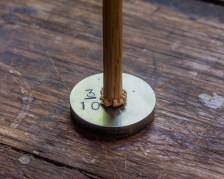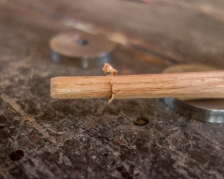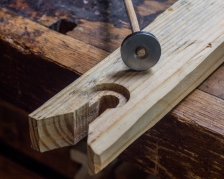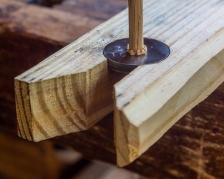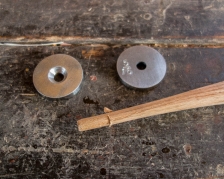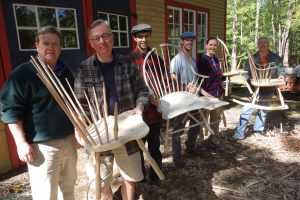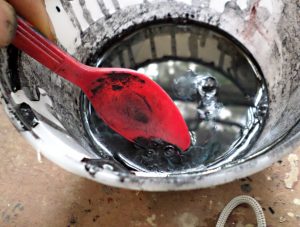Bodgers
by Elia Bizzarri | Feb 25, 2017 | 0 Comments
“Not a lot of money in that is there?”
“No, not a lot of money…. Still we’ve always done it… Money’s not everything.”
Bodgers were wood turners who worked in the beech woods around the furniture-making town of High Wycombe in England. They would cut, split and turn the beech trees where they fell, then sell the legs and stretchers to another shop where the chairs were assembled.
This kind of specialization has been common for hundreds of years in both England and America. The Windsor Style in America has a quote from the December 27, 1775 Pennsylvania Gazette for a chairmaker wishing to purchase “40,000 hickory sticks [likely spindles] for Windsor chairs.” Nancy Goyne Evan’s Windsor Chairmaking in America has documented myriad transactions like this. read more…
Dowel Plates/New Class
by Elia Bizzarri | Feb 9, 2017 | 0 Comments
Over a decade ago, a customer told me he used a dowel plate to cut the tenons on his spindles. “That won’t work,” I replied, having never tried it myself.
Last fall, I switched to using dowel plates to cut the upper tenon on the spindles.
Why did I switch? Primarily, I find that the cut is often cleaner than a tenon cutter’s cut. And they have some other advantages: the dowel plates never need re-adjusting, and almost never need sharpening. They are also self limiting: if the tenon is too big, you simply can’t drive it through the hole.
Pitchforks with Curtis
by Elia Bizzarri | Jan 29, 2017 | 0 Comments
I’ve made a few pitchforks for historical museums over the years, though I can hardly say I’m an expert. Curtis Buchanan called me a few months ago and said he wanted to make a pitchfork. Here’s some photos from my weekend in Jonesborough, eating the Buchanan’s good food and making pitchforks with Curtis and a neighbor of his. We had a ball! Thanks to Curtis’s neighbor Ben for taking many of these photos:
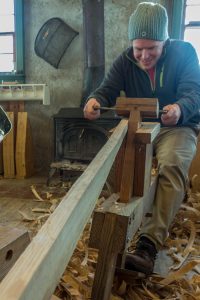 The process starts much as a chair back does: riving, squaring, tapering, octagonalizing…. read more…
The process starts much as a chair back does: riving, squaring, tapering, octagonalizing…. read more…
Mountain Shovel Maker
by Elia Bizzarri | Jan 15, 2017 | 0 Comments
I just stumbled upon this old Folkstreams video for the second time – it’s well worth watching. A poplar or basswood log and five tools: scribe, ax, adz, drawknife and a knife. No work-holding devices, but a neat way to hold the shovel using his feet and legs. That old man could work.
Barstool Reproduction
by Elia Bizzarri | Jan 1, 2017 | 0 Comments
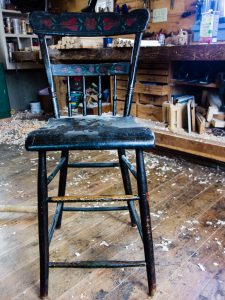 I just started a fun job. A customer wants two copies of this early 19th C. barstool. I love getting to spend time with old chairs like this – there is so much to learn. Last week I turned the turned parts and bent those that get bent. read more…
I just started a fun job. A customer wants two copies of this early 19th C. barstool. I love getting to spend time with old chairs like this – there is so much to learn. Last week I turned the turned parts and bent those that get bent. read more…
Chair Stories: Grandma’s Linseed Oil
by Elia Bizzarri | Dec 27, 2016 | 0 Comments
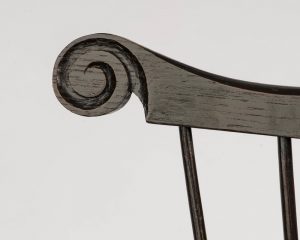
This week I shipped a Fan Back and a Birdcage Side Chair to Rene in California. Here’s the story that went along with her chairs (I’ll get back to some how-to articles soon):
My Grandmother was a hands-on sort of woman. She was an artist and drew medical drawings professionally before marriage. Being the holiday season, I was thinking about her today while I put the finish on a Fan Back and a Bird Cage chair. I remembered the story I wrote the day she died:
My grandmother, as a young mother, enjoys furniture refinishing for a hobby. She goes to buy boiled linseed oil from the hardware store. But on this day, the store is out of boiled linseed oil; raw linseed oil is all that’s left. read more…
2018 Chairmaking Classes
by Elia Bizzarri | Dec 10, 2016 | 0 Comments
I have added several classes to my 2018 schedule (more info on my teaching page): read more…
Black-over-Red/Oak for Sale
by Elia Bizzarri | Nov 9, 2016 | 0 Comments
We’ve painted the red coats on our rocker in a few previous posts, so it’s time for the black:
Make sure you spoon the foam off the top of the paint. I do this every time I mix up paint. Some brands of paint have more foam than others. read more…
Kiln Heaters
by Elia Bizzarri | Oct 15, 2016 | 0 Comments
Part two of my three part kiln series.
Kilns can be heated in two different ways. The heat source can run all the time, so that the temperature of the kiln is relative to the temperature of the air in your shop. Or the heat source can be controlled by a thermostat – either one you add or one that comes with your heater – so that the temperature of the kiln is always the same regardless of the temperature of the air. If your shop is heated it probably doesn’t matter which way you go, but if your shop is down at 30 degrees and your kiln is at 130, you are wasting a lot of energy. See previous post for more info.
Kilns can have a number of different heat sources. I have used all of these at one time or another:
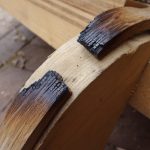
This back got too close to a bulb!
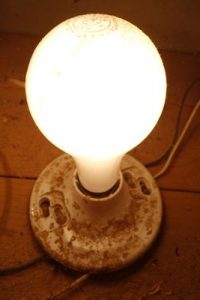 Incandescent Light Bulbs: These are 90% efficient at producing heat (and only 10% efficient at producing light), and they are great heat sources for a kiln. 200-300 watts worth of bulbs will heat a 2x2x3′ kiln, which is plenty big enough for anyone building one chair at a time. Wood contacting the bulbs will char (see photo), so a heat shield (flashing, etc.) is a absolute must. read more…
Incandescent Light Bulbs: These are 90% efficient at producing heat (and only 10% efficient at producing light), and they are great heat sources for a kiln. 200-300 watts worth of bulbs will heat a 2x2x3′ kiln, which is plenty big enough for anyone building one chair at a time. Wood contacting the bulbs will char (see photo), so a heat shield (flashing, etc.) is a absolute must. read more…
A Cool Old Joint
by Elia Bizzarri | Sep 18, 2016 | 0 Comments
The last time I saw Jennie Alexander was 15 years and two months ago. She was John then and I was a 17 year old kid. I spend three weeks living in Baltimore learning to build a 17th century joint stool and learning to think like a lawyer.
I visited Jennie on my way to Maine a couple weeks ago. She has a huge collection of 18th and 19th century broken chairs and chair parts. Here’s one joint I saw (apologies for the crumby photos):
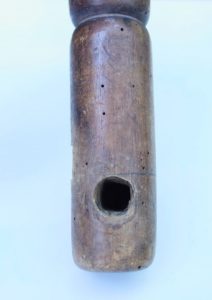 A roughly square mortice. This is probably a post-and-rung chair, but I have seen examples of this joint on Windsors as well. Note that the mortice isn’t really square. read more…
A roughly square mortice. This is probably a post-and-rung chair, but I have seen examples of this joint on Windsors as well. Note that the mortice isn’t really square. read more…
Subscribe to Elia's Blog
Recent Posts
Search the Blog
Donations
Donate below to help keep the blog going. Thanks!
Categories
- Chair Stories (32)
- Chairmaking Tools and Supplies (42)
- Chairs For Sale (5)
- Classes (58)
- Craft Films (43)
- How-To (40)
- Antique Chairs (8)
- Drill Bits (3)
- Spoon Bits (3)
- Finishing (9)
- No-Glue joints (2)
- Samuel Wing Book Project (10)
- Sprinpole Lathe (2)

